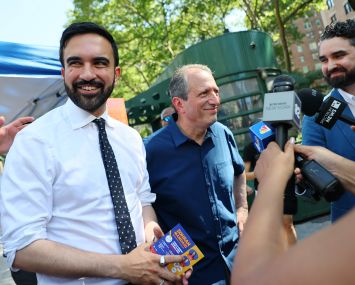 Since 2008, Hal Fetner has been the president and CEO of Durst Fetner Residential, the joint venture with the Durst Organization that has developed high-end residential projects across Manhattan and the New York metro region. Besides the Epic and the Helena, a pair of LEED Gold projects completed several years ago, the group has most recently spearheaded developments at 1212 Fifth Avenue, 855 Sixth Avenue and West 57th Street, the high-concept, 600-unit residential building between 11th and 12th avenues. Mr. Fetner, 50, talked about these projects and the residential development market in general.
Since 2008, Hal Fetner has been the president and CEO of Durst Fetner Residential, the joint venture with the Durst Organization that has developed high-end residential projects across Manhattan and the New York metro region. Besides the Epic and the Helena, a pair of LEED Gold projects completed several years ago, the group has most recently spearheaded developments at 1212 Fifth Avenue, 855 Sixth Avenue and West 57th Street, the high-concept, 600-unit residential building between 11th and 12th avenues. Mr. Fetner, 50, talked about these projects and the residential development market in general.
The Observer: What’s the latest with your residential condominium project at 1212 Fifth Avenue?
Mr. Fetner: At 1212 Fifth Avenue, we’re opening up our sales office, officially, any day now. This is the culmination of about three-and-a-half to four years’ worth of planning and work, and we are completing a total gut rehab of 1212 Fifth Avenue.
We have the luxury of having been able to vacate the entire building, so by having a completely empty building I was able to really redo the entire mechanical system in the building as well as all the floors. All the interior walls except for the core of the building were removed, and what we ultimately were left with was a prewar building with modern layouts.
She’s really, truly a beautiful building.
Do you feel confident with the condominium market now? It was only a few years ago that developers stepped back, choosing instead to market rental apartments.
There are a number of reasons why I feel confident. What we’re seeing—and we saw it [earlier this month] in some of the reports that came out—is that the buyers had been on the sidelines, and they had been renting. And we’re predominately rental developers, and we’ve definitely seen an increase in our rents across our portfolio. That’s primarily because a lot of the buyers were on the sidelines, waiting for the market, and waiting for what they perceived to be value.
What you’re seeing right now is that in a lot of the buildings that were built and/or converted a while back, they were asking very, very high prices. They’ve now been lowering their prices to a point where you’re starting to see a surge in family-sized apartments. The larger apartments are starting to sell, and it’s really directly related to the fact that now the consumer is starting to see what they perceive to be value.
And 1212 Fifth Avenue, we started advertising about four or five weeks ago, and we’ve got about 500 people who have expressed interest. They’re on a waiting list to come in and see the apartments!
I will tell you that we accepted our first offer last night, on a very large apartment in the building—and that’s without really having opened up our sales office. It really basically validates what we’ve thought, which is that there is a market right now where the larger units are seeing value.
What’s happening with 855 Sixth Avenue?
We’re in the design and development phase right now. Being that we’re trying to make a transformational design on West 57th Street, we also have decided that we wanted to do something unique on 30th Street. So we have a really innovative design where we are going to basically have a retail base.
Right now, we’re talking to a number of different hotel groups for a hotel in the middle of the building and then approximately 300,000 square feet of rental residential above the hotel.
What’s the time frame for construction?
We’re hoping to break ground on that by April of 2012.
With regards to ground-up development, is the market strong enough to return to the day when potential buyers were making purchases based on the blueprint alone?
Because we’re part of the Mount Sinai community, we’re showing a lot of units to doctors. They want to see, they want to touch. I’ve met with some of these clients, just to observe them looking at the units so I can pick up on what they’re liking and what they’re not liking. I can’t conceive of these people who I’ve met over the last week or two buying off plans. As a sophisticated investor myself, I don’t think I would buy off the plans, not knowing the reputation of the sponsor-developer.
Are you beginning to see more development in New York, or is it still sluggish?
In talking to our architects, and talking to other architects, we have heard that they have been looking at sites, which means that somebody is snooping around the sites. But I have yet to hear of any larger sites trading. We’ve been hearing about sites in the 100,000-square-foot range, but we haven’t heard about any larger sites.
With West 57th Street, how did you connect with the architect Bjarke Ingels?
Douglas [Durst] spends a considerable amount of time in Denmark, and Douglas went over to Denmark one year and gave a lecture or a speech. The folklore is that, after the speech was over, Bjarke came up to Douglas and asked him why all his buildings looked like buildings. And they then struck up a conversation, and Douglas really enjoyed speaking with Bjarke.
So we really couldn’t decide what to do with West 57th Street—because the empty lot has gone through a lot of different plans—and one day Douglas said, ‘Why don’t we talk with Bjarke and see what he wants to do?’
But Bjarke is extremely brilliant, he’s innovative and he has lots of enthusiasm.
Does this mark a renewed interest from developers in hiring so-called ‘starchitects’?
I’ve never bought into the term “starchitect,” I just never have. And you know what? I don’t know if it is back or if it’s not back but I’ll tell you this: I don’t think we necessarily needed a starchitect for West 57th Street. We needed innovative design. We needed somebody who could help us overcome certain obstacles of this site.
And for us, the largest obstacle was we have a spectacular building there right now called the Helena, and then I have an empty lot where I had to use up 800,000 square feet of FAR. So how do I do that and not block the views of the Helena? And Bjarke came up with a great idea, and from the river it’s a focal point to Manhattan.
With West 57th Street as well as the other Durst Fetner projects, such as 1212 Fifth Avenue, where is the financing coming from?
We are extremely, extremely fortunate that we have banks who, the second we say we’re doing a rental, they’re all over us. And they want a piece of the deal. About 20 minutes ago I got an email from a banker I haven’t spoken to in four weeks saying, ‘Hey, want some update from you on how you’re making out on 30th Street.’ Why? Because they want a piece of that financing.
The underwriting today is definitely more stringent than it was years ago, but if you’re really not an A developer you don’t have the equity to put it up because the equity requirement is much more. And that’s assuming that they even want to make a loan to you.
So we have been very, very fortunate to enjoy really good relationships with a lot of strong banks.
Are you more focused than you had been on distressed assets, or no?
We’re focused on assets, O.K.—wherever we can find them that makes sense for us. And when I say, ‘makes sense for us,’ I mean to say we’re very long-term minded. When you’re long-term minded, and you want to put your equity to work, this is an environment that works for us in that we are able to be sort of more opportunistic.
jsederstrom@observer.com


